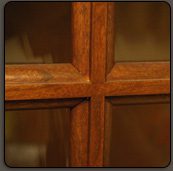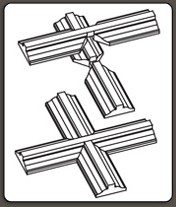A Primer on Joinery
– When making furniture or woodworking projects, you often need to get pieces of wood to join together. This can certainly be done with screws and glue, but a more time tested (and honored) method is to use Joinery. Joinery is the process of making interlocking parts with the pieces of wood and fitting them together like a puzzle.
Joints fall into two categories:
- Glue Only Joints -where the wood pieces are held together with just glue
- Mechanical + Glue Joints where the pieces are held together with both glue and some sort of mechanical locking mechanism – check out dovetails as a great example of this type of joint.
Let’s take a look at one of the simpler glue only joints – the Lap Joint.
Lap Joints 101
A lap joint falls into the category of halving joints – where two halves make a whole. It is a relatively easy joint to cut and a great learning joint if you are just getting going in woodwork.
While not particularly strong, lap joints are simple joints you can use to make picture frames and mirrors. As with most joints, there are variations, but all of them rely on the long grain glue surface area (the cheek of the rabbet) for their strength.

Lap Joints Are Made of Rabbets
Let’s start by looking at the parts of the lap joint and some of the guidelines you can use.
Each piece of wood has a pair of cuts made on it – one horizontally, one vertically. These cuts result in something called a RABBET (from the French word rebate).
The different parts of a rabbet are as follows:
General Guidelines when laying out the Rabbets for a Lap Joint
There are two general guidelines when cutting rabbets. Not following them could interfere with the structural soundness of the joint.
- Length of cheek should not be more than the width of the wood
- Depth of the shoulder should not be more than half the thickness of the wood.
How To Cut Lap Joints
You can cut a lap joint with a wide variety of tools such as the table saw, bandsaw, handsaw but the most important aspect is that they are cut accurately.


Different Types of Lap Joints
There are lots of different types of lap joints but they all rely on halving the face in one way or another.
Where Can You Use Lap Joints?
Lap joints are often used in latticework and Kumiko – Japanese latticework – shows this to great effect.

You can use them to make dividers in boxes

Simple frames around doors (that aren’t heavy) or mullions for glass paneled doors or windows.


The lap joint is also a great joint to do if you have been out of the shop for a while or if you need to get your brain warmed up.
If you are new to woodworking or joinery this is a great joint to start with and if you need a bit more help, consider taking a JOINERY CLASS at the Florida School of Woodwork in Tampa Florida.







